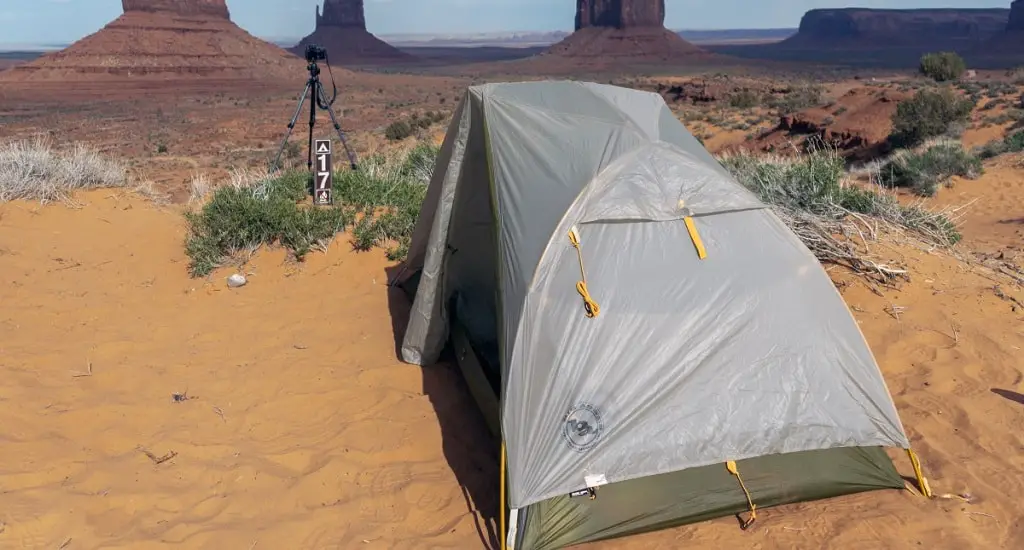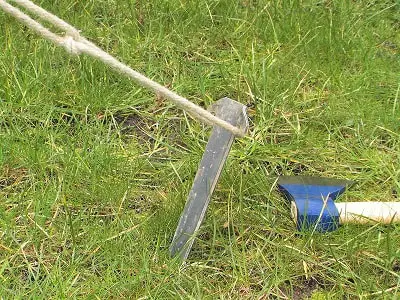Setting up a tent might be tricky sometimes, especially when you are camping in sandy environments. The primary factors you should take into account are keeping the tent steady in the loose ground while maintaining it clean. To answer these two requirements, I’ve gathered you five essential tips that will solve the open-ended question; how do you pitch a tent in the sand?

To pitch the tent in the sand correctly, you should first secure it in the sand by using long and sustainable pegs – those that are made of aluminum are preferred. Then, you should add a few rocks and sandbags to the bottom, so that the canvas resists the strong winds and maintains steady. Also, you should pack a tarp along the way to use it either underneath or above the tent; it would protect you from the burning sun and the flying sand particles. Finally, make sure that you pick the right ground – it should be neither damp nor too loose.
1. Use Adequate Pegs
To get a stable tent, you need to use unique pegs. The ones that you purchased with the tent might not be helpful. This is because they are short and will not hold the canvas well.
There are bigger pegs that will do the work right. They are long; hence, have a large surface area – that way the tent doesn’t waver with the strong winds. Other pegs feature some holes that can be attached to the canvas. There are several tent pegs you might choose, which would be sturdy enough to anchor tour tent.
Fenical aluminum tent stakes will do the trick. They are made of aluminum, which is durable and would sustain strong winds. Also, these pegs are 18 cm long – the length is essential, so they go deep enough. Kinglake pegs at 12 inches are another option which will also work.

Then, you have to tie a rope to the tent stakes through the hole at the bottom and attach them to your tent. After that, you should bury the stake in the sand as deep as you can.
2. Consider Using Rocks
Rocks might help you pitch a tent in the sand as well – the big ones would be best to use. Large stones would make the tent stronger at the bottom and finding them shouldn’t be a difficult task.
If you are at the beach, the rocks are readily available. For the stones to function correctly, you will need to wrap and then tie the guy line around them.
This will assure you of a steady tent – the last thing you want is the tent being blown away. On that scenario, you will consistently have to fix it, and your camping adventure would be ruined.
3. Try Sandbags
Sandbags are perfect for anchoring a tent and can be quickly filled when camping in a desert or at the beach. Since it is such a convenient method, you don’t have to sweat to make sandbag.
For that task, all you need are the proper materials. Merely get some shopping bags and fill them up with sand. Make sure they are big and strong enough to hold the sand without tearing.
You should also tie them well to avoid any sand spillage in the tent. Then, position the sandbags at each corner of the canvas from the inside.
Some tents do not feature floors. If that is the case, tie the sandbags to the tent corner via the guy lines. Now, you can comfortably relax – you have an impressively immovable tent.
Cover The Sand Bags
The sandbags should be some inches deep in the ground, so they stay fixated. You may dig a few holes underneath your tent for that purpose.
For sand being so soft, you shouldn’t have any troubles doing so. After that, position the bags in the holes and tie them to your tent’s corners. Then, cover them up with some sand until you have a flat platform to work on.
That process is preferred for small canvases with a limited amount of space from the inside – you will both gain room and wind resistance.
Add Some Water to The Sandbags
A durable tent will give you an undoubtedly great time at the beach. You can get creative by enhancing the weight of the bags by using water.
Pour some a little amount into the sandbags – do it gradually, so you don’t flood your tent with mud. Once you are done, seal the bags entirely so that the water doesn’t evaporate.
When you finally take off, make sure that you move the containers gently, so that they do not tear under the heavyweight. That process is crucial since when they are heavy enough, the bags will hold the tent firmly to the surface and resist any harsh conditions and winds.
Maintain The Bags
As time goes by the firmness of your bags might reduce. It could be due to a leakage some gentle movements by the wind – either way, you should put a little extra effort on maintenance.
If the bags aren’t firm enough – they have probably leaked, and you should add some sand to them. On the other hand, if they move freely in place – you should probably add some sand to their holes, so they keep fixated.
Don’t get obsessed about it – it is okay not to have the perfect features. Once you have a couple of bags – the rest would compensate once one had gotten weak.
4. Pack a Tarp
When you pitch a tent in the sand, it is essential to bring a tarp along the way. When you hang it over your tent, it would shelter you from the burning sun and catch flying sand particles.
To do that, you should know how to use the right knots and bring the proper rope. On both, I’ve discussed elaborately in the article – 15 camping knots that actually work and used worldwide.
You will also benefit from placing the tarp underneath your tent, although it is crucial you do it right. In short, you should keep its four corners folded towards the outside so that sand doesn’t accumulate from the inside.
5. Pick The Right Ground
Setting up a tent in the sand could be tricky since the stakes might be loose when stuck into the ground. The proper field should be a little stiff and feature a solid structure underneath the sand.
If your tent stands merely on a sandy surface, it would bend easily and won’t resist the winds well. When you have no choice, and solid ground is out of reach, you could tie your tent for a rock or a tree which are more sustainable.
If you chose to camp on the beach, make sure you pick a dry ground. If the surface is damp, it might be due to the tide, and there is a good chance your belonging would get wet during nighttime.
How Deep Should The Sand be?
When it comes to the sandbags – the depth of the holes should be at least the length of the bags themselves. It is essential that they are entirely buried, so you regain that extra space while maintaining steadiness.
The same goes for the pegs you’ve picked to hold your tents – if you took my advice and picked long ones, the depth of the sand should be at least 18 cm. When you pitch a tent in the sand, it is crucial to take into account its dimensions and weight.
Bigger tents feature a more substantial surface area and are more exposed to strong winds, especially if you are camping at the beach. Hence, bigger tents require longer pegs and deeper sand to rely on.
How to Repack The Tent in a Clean Condition?
To repack your tent clean, you should first keep the tent tidy from the first place. The best strategy would be leaving the shoes outside and zipping the canvas during nighttime – I will elaborate on that matter later on in this article.
When it is time to pack and leave, you should first unzip all the zippers and shake out the tent firmly. Another crucial factor is to dry the tent before packing it.
When the sand particles are wet, they tend to stick to your canvas and would probably endure the shakes. Hence, you should pack up your tent a few hours past sunrise to avoid the moisture accumulated during nighttime.
Do not stuff your tent in wet conditions – it would make it sticky and compromise its water resistance. Repacking it the right way will give you a canvas that can last for quite some time.
How to Pitch a Tent in The Desert?
Since it is probably hot, you should first seek for a shaded area. If you find a hill, try to pitch your tent from its west side. This way your canvas will be covered from the sun rising from the east in the morning and won’t get too hot.
You may also unzip the tent for better air circulation during the day. Make sure that you leave a small opening so that sand particles and animals won’t be able to enter from the bottom.
A quality opaque tarp will also be needed to cover the sunlight – that is one of the reasons why you should put a tarp over your tent. At night temperatures drop down, and you should zip up your tent to avoid scorpions and snakes while maintaining warmth.
When it comes to stability – the instructions mentioned above still apply. It is crucial to pay attention to that factor since the desert winds could easily carry your tent away.
Furthermore, you will need a few substantial tent stakes since the ground is many times harder at the desert – aluminum should be okay.
Sandbags will also offer some safety against sandstorms and prevent sand particles from entering from the bottom. Use as many bags as possible to get a solid foundation.
Can I Put a Tent on The Beach?
It is possible to pitch a tent on the beach, but you want to ensure that the guy lines are firmly fixed into the sand.
Using regular pegs may not be the best course of action; instead, you can purchase sand anchors at an outfitter store or, alternatively, improvise by finding stuff like rocks and pieces of driftwood around the beach to anchor your tent with.
For instance, you can look for a small branch and attach your guy line to it before burying the stick deep into the sand. This should hold your tent firmly; make sure you do the same for each guy line on the canvas.
Considering that it is on a beach where the wind blows quite often, you can reinforce your tent by pushing a wall of sand around the base of your tent.
How do I Keep The Sand Out of my Tent?
To keep sand out of your tent, you want to make sure all footwear strictly stays out of the shelter. This is because sand particles tend to stick on your socks and soles of your shoes, making it easy to be carried inside.
You also want to keep your tent zipped up as much as possible. This way, there is little chance of sand grains getting blown inside.
Remember that these sand particles are very light and even a gentle wind can get a significant amount of sand into your tent.
Finally, you can cover the edges of your flysheet with a few inches of sand to minimize flapping when the wind blows and stop any sand from being blown into your tent.
Conclusions
Setting up a tent in the sand might be challenging, although it could be quite pleasant when you approach it from the right angle.
The main problem with camping on a sandy surface is that the tent might stand loose. To secure it in its place, you should use the appropriate pegs and pick the right ground.
If you hang up a tarp, as a shelter, things will get even better. When you camp on the beach, make sure that there is solid ground underneath the sand so that the stakes keep fixated.
If you camp in the desert, ensure that you’ve found a shaded area and that you zip the canvas entirely during nighttime.
Either way, pack up the tent in a dry condition and make sure you shake all the sand from it before putting it into the carrying sack.
I hope my article had answered your questions. If you have any new ideas or questions, let me know all about them by leaving a comment below!

